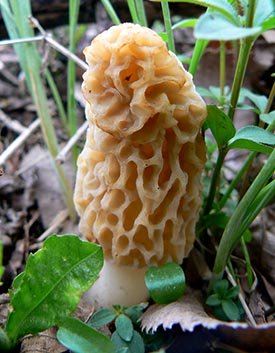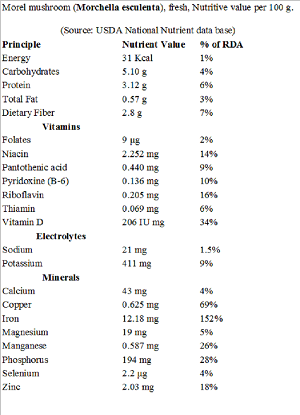Morel mushroom Nutrition facts
Morel mushrooms, or Morchella, are a type of edible wild mushrooms found in the hardwood forests of the Northern Hemisphere, from the Arctic and subarctic regions of North America to Siberia. Morels are highly prized mushrooms, valued for their rarity and savory flavor.
Family: Morchellaceae.
Scientific name: Morchella esculenta.
 |
| Morel mushroom. Courtesy: Thomas & Dianne Jones. |
Identification
Morels feature brown, spongy, honeycomb-patterned conical caps, and long, hollow, light-colored stems completely attached to the cap.
There are several sub-species of Morchella mushrooms grown in the wild, out of which black morels, brown, and yellow morels are typically foraged in the forest. Morels grow in fertile organic, moist, and sandy soil. A completely developed morel mushroom measures about 6 inches in height. In subarctic coniferous forests, they are typically foraged during the spring season in areas burnt by wildfires during the preceding summer. In hardwood forests, they are found in abundance around the base of elm, ash, aspen, cottonwood, and oak trees.
False morels (Verpa bohemica) may often be confused for true morels by young pickers. Verpa features a long, sturdy stem that is very loosely attached to the cap.
Gyromitra esculenta, another mushroom that mimics real morels, possesses the gyromitrin toxin. They feature a large, irregular, dark reddish-brown, gyriform (brain-like convolutions) cap.
Health benefits of Morel mushrooms
31 calories. Nonetheless, they are endowed with superb levels of health-benefiting antioxidants, essential minerals, and vitamins.
Morels carry the highest amount of vitamin D among the edible mushrooms. 206 IU or 34% of the daily required levels of vitamin D are found in 100 grams of raw morels, mostly in the form of ergocalciferol (vitamin D-2). This fat-soluble vitamin is labeled as a "hormone" for its role in bone growth and calcium metabolism.
Morels are unique among wild edible mushrooms, recognized for their rich mineral content. 100 grams of raw morel carry 69%, 152%, 26%, and 18% of copper, iron, manganese, and zinc levels, respectively.
Copper is one of the essential trace elements that function as a co-factor for many oxidative enzymes involved in cellular metabolism. It is also required for blood cell production (hematopoiesis) and neurotransmission.
100 grams of morel mushrooms carry 194 mg or 28% RDI of phosphorus and 43 mg of calcium. Adequate calcium, phosphorus, and vitamin D levels in the blood are critical for the growth and development of bones and teeth.
Zinc is an essential nutrient that plays a vital role in cellular metabolism, mucosal regeneration, immune function, and reproductive organ growth.
Additionally, these mushrooms are an excellent source of the B-complex group of vitamins such as niacin (14% of RDA per 100 g), riboflavin, pantothenic acid, and vitamin B-6 (pyridoxine). Altogether, these vitamins work as co-factors for enzymes during cellular substrate metabolism inside the human body.
 |
Selection and storage
Morels are "wild harvest" mushrooms and cannot be cultivated on farms, unlike shiitake or button mushrooms.
The fresh morel season lasts from late April until June in the United States. Their arrival is eagerly awaited by several hundred Morel enthusiasts each season. Mushroom hunters often take cues from the blooming of lilacs, bluebells, and dandelions after spring rain. Typically, they forage fully grown morels by trimming them at the base of the cap using a paring knife.
Fresh morels are often sold in farmers' markets or civic-municipal markets. Amateurs should always accompany an experienced picker while foraging.
Fresh morels perish quickly unless dried or frozen. To store them, place the fresh harvest inside a paper bag and keep it in the refrigerator. Do not store them inside a plastic cover since they sweat, become soft and mushy, and decay sets in early.
Dried morels can be stored for several months and are usually exported to overseas markets. Homemakers often steam, braise, or sauté them before freezing them for extended usage.
Preparation and serving methods
Fresh morels are highly coveted mushrooms, particularly in French cuisine.
It is essential to always cook morels before consumption, as eating them raw could lead to stomach upset. Since they are field mushrooms, morels tend to collect sand and grit in their crevices and require cleaning. Soak them in cold salted water for a few minutes, then strain and rinse them again in cold water for a few seconds to eliminate any salty taste. This cleaning method should be applied only to morels intended for cooking.
Morels retain their flavor even after drying. Dry morels should be reconstituted by soaking them in lukewarm water for 20 minutes. This soaking process swells them up, allowing them to regain their original conical shape. After soaking, dry them using a paper towel. Slice them lengthwise or into quarters, depending on your preference for cooking.
 |
| Butter sauteed morel mushrooms. Photo: Larry & Teddy Page |
Here are some serving tips:
Morels can be stewed, braised, or cooked in main dishes such as rice, poultry, game, and fish (such as wild-caught halibut with morels and baked cod with morels).
Traditionally, morel mushrooms are enjoyed pan-fried in butter and garlic cloves, with the addition of some salt and pepper.
You can also add sliced morels to soups.
Fine-sliced or diced morels can also be used as add-ons in pizza, pasta, risotto, etc.
Safety profile
Always cook morels before eating. Allergic reactions to the consumption of true morel mushrooms are rare.
False morels (Verpa bohemica) may often be confused for true morels. Repeated and prolonged consumption of V. bohemica may cause poisoning similar to Gyromitra esculenta, another mushroom that mimics real morels. Both possess the gyromitrin toxin, which may cause stomach upset, vomiting, diarrhea, lethargy, muscle weakness, etc.
Although people in some countries relish false morels, caution should be exercised to avoid their toxicity. (Medical disclaimer).
You may also like to read≻≻-
Bolete mushroom nutrition facts and health benefits.
White Button mushrooms nutrition facts and health benefits.
Shiitake mushrooms nutrition facts and health benefits.
Truffles nutrition facts and health benefits.
≻≻-Back to Mushrooms from Morel mushroom. Visit here for an impressive list of edile mushrooms with complete illustrations of their nutrition facts and health benefits.
≻≻-Back to Home page.
Further reading and Resources:
Productivity and diversity of morel mushrooms in healthy, burned, and insect damaged forests of northeastern Oregon.